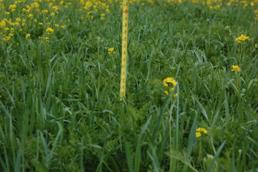Author: Nick Andrews
Publish Date: Spring 2009
Cover crops are widely used to reduce soil erosion and increase soil organic matter. When legumes are included in the seed mixture, the cover crop can provide a lot of nitrogen (N) and reduce the need for fertilizer. The N content of cover crop stands varies widely (figure 1), and we don’t currently have a reliable method for estimating the nitrogen value of the cover crops, especially when cover crop stands are a mixture of non-legumes and legumes. However, with funding from Western Region Sustainable Agriculture Research and Education (https://western.sare.org/) and the USDA, we are making progress. In the spring 2007 issue of Oregon Small Farm News (page 6), I described three N-estimation methods that could be used on farms. In the recently completed WSARE-funded portion of our research (Estimating Nitrogen Contribution from Cover Crops on Organic Vegetable and Cane Berry Farms, FW 06-301) we compared five methods for estimating N from annual cover crops. As a result of the research, we recommend the bulked species method. It is relatively easy to use, and compares very well to the separated species method, our standard laboratory method. The steps below walk you through the recommended bulk species method.
Step 1.
Make a 2’ x 2’ sampling frame, we used aluminum.
 Step 2.
Step 2.
Carefully work the frame down to the base of the plants, making sure to only include the plants that are rooted within the frame. Cut the plants at soil level. Select at least 6 representative areas to sample per acre. No more than 15 would be needed from a large field with one type of cover crop stand. The more samples taken, the more reliable the estimate will be. We found it much quicker to use a harvesting knife than shears. We collected the samples in paper bags, but large plastic bags are fine too, just make sure the plants don’t wilt.
Step 3.
Record the total area sampled (table 1, line 2), and weigh the fresh weight of your total sample (table 1, line 1).
Step 4.
Quickly cut up the largest weeds or cover crop stems enough to enable thorough mixing of the cover crops. Mix well on a large table or clean floor, as this needs to be a uniform mix. Then take a representative sub-sample of 0.5-1.0 lb and record the fresh weight in table 1, line 3.
Step 5.
Send the sample to a reliable lab (see “A List of Analytical Labs Serving Oregon”: http://smallfarms.oregonstate.edu/soil-testing). Ask the lab to dry the whole sample, weigh the dry sample and provide sample dry weight (table 1, line 6), total N (table 1, line 7) and total C.
 Step 6.
Step 6.
Calculate the total nitrogen contribution of the cover crop using the worksheet below (table 1.)
Plant-Available Nitrogen (PAN):
The major finding of this WSARE funded research was that total N estimates using the bulked species method compare well to the results from the analysis of separated species. This allows farmers to save the time of separating indicidaul species. We hope this will make it more feasible to estimate N from cover crops. The other methins we tested wer not as accurate, and were easier to use than the bulk species method. In this study we compared methods to estimate total N.
However, nitrogen from grasses and forbs is less plant-available nitrogen from legumes. If we are to gain confidence in cover crops as a source of nitrogen, we need a method to estimate plant availability (PAN) from cover crops.

We used the N-mineralization model in the OSU Organic Fertilizer Calculator (http://smallfarms.oregonstate.edu/calculator) to test whether the bulked species method is capable of estimating cover crop PAN reliably. This model was developed for fertilizers, but it attributes different PAN values to grasses and legumes based on their N content. The comparison of the PAN estimates generated by the bulked species method and the separated species method is shown in figure 4. The line drawn between the data points shows a very strong correlation between the two methods. Therefore, we can conclude that the bulked species method described here is sufficiently accurate to give useful PAN estimates. However, the mineralization model in the Organic Fertilizer Calculator has not been validated for cover crops. Our study proved the concept, that the bulked species method can estimate PAN, but we don’t recommend using the Organic Fertilizer Calculator for cover crops.

With funding from the USDA, Dan Sullivan, John Luna and I are now conducting the research needed to estimate N mineralization from cover crops. Initial results are promising, and we expect to complete this phase of our research this year. We plan to post a Cover Crop Calculator online at the OSU Small Farms website in time for the 2010 season. Stay tuned for the rest of the story.
[Part one of this article appeared in the Fall 2008 issue, Vol 3. No. 4 or the Oregon Small Farm News]


